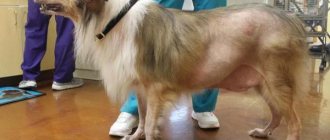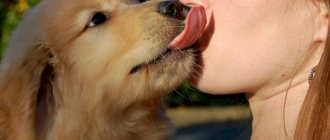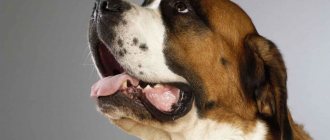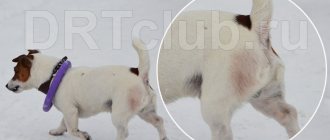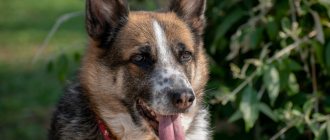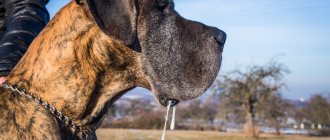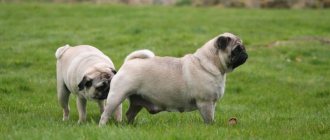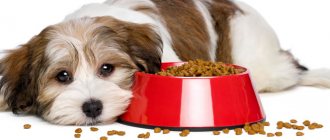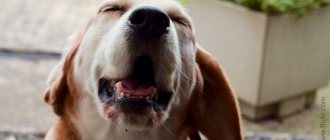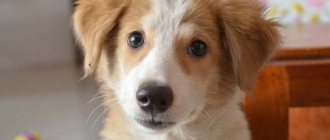Any owner will be wary if a dog's nose becomes lighter. It is especially strange when pink stripes or even spots appear on a completely black nose. Should we worry, and what are the reasons for such changes, we will discuss below.
Let us immediately note that most dogs have a black or brown nose . This pigmentation corresponds to breed standards and plays an important role in the assessment. Only for a few breeds is lightened nose pigmentation accepted as the norm. We should not forget about the existence of albinos , who, although recognized by tribal marriage, have pink noses and feel quite comfortable.
Other causes of pink nose
There are autoimmune diseases that can affect the color of a dog's nose. In these cases, medical attention is required. Examples:
Vitiligo
This is an autoimmune disease that causes pink noses in dogs. Other signs of vitiligo include white patches or hairs all over the dog's body. The reason for this is that the body produces antibodies that fight the pigments in the dog's body. These antibodies kill the cells that cause the loss of color in your dog's nose and coat.
To find out if vitiligo is the cause of your dog's pink nose, your veterinarian will perform a biopsy.
There are certain breeds of dogs that are susceptible to this autoimmune disease. These are the dog breeds:
- rottweiler,
- German Shepherd,
- doberman,
- dachshund.
Although this autoimmune disease does not affect overall health, nutritional supplements can be given to restore pigmentation. Vitiligo is not a fatal disease for dogs.
© shutterstock
Pemphigus
This is another type of autoimmune disease that affects the skin. There are three causes of pemphigus. The first is called endogenous, which is caused by factors in the dog's body itself, such as genetic predisposition. The second is called exogenous and is caused by external factors that provoke inflammation of the skin. The latter is caused by reactions to certain medications.
Veterinary help is necessary if your dog has a pink nose - pemphigus. Treatment includes corticosteroids and immunosuppressants. Most dogs respond well to treatment.
lupus erythematosus
This is another form of autoimmune disease that causes a dog's nose to turn pink. In this case, the dog's own immune system is responsible for attacking the tissue. Dog breeds known to be affected are collies, German shepherds, Siberian huskies, hounds, Afghan hounds, chow chows and Scottish shepherds.
Uveodermatological syndrome (UDS)
In this case, the cells of the affected dog are attacked by melanocytes, or melanin-producing cells. Because melanin gives color to the skin and nose, a dog with this condition will have a pink nose.
Black color
Black Labrador, which fully complies with the standard, is characterized by a completely resin color. The limit of the acceptable norm is considered to be a barely noticeable whitish spot in the chest area of the animal. The nose of a purebred black Labrador is charcoal in color and lacks pigmentation. However, during the lack of sunlight that characterizes winter and autumn, the nose of a black Labrador may lighten to a pinkish tint. The pigmentation around the eyelids and lips is also pure black. The eyes of a black Labrador have a rich brown, less often a hazel tint.
Disqualifying faults for black Labradors include:
- motley spots of white, red and brown;
- nasal pigmentation.
Genetics
Labrador color plays a key role in breeding pedigree dogs. There are established combinations of genes responsible for the color of Labradors, and a detailed study of the Labrador's pedigree allows one to avoid problems with the purity of the breed.
In genetics, the letters B and E indicate black coat color. These genes are both dominant. Chocolate and fawn colors are indicated by the letters b and e, and these are recessive genes. There are 9 different gene combinations in total. A puppy receives a pair of genes from each parent.
A black Labrador with the EEBB gene combination has only black dogs in its family. However, if you breed such a Labrador with a carrier of one of the recessive genes (fawn or chocolate), then there is a possibility that the puppies, upon reaching the age of an adult dog, will give birth to fawn or brown Labradors.
The birth of black puppies from fawn parents becomes a cause for surprise among inexperienced breeders. However, from a point of view, this situation is not at all surprising: a fawn Labrador, regardless of gender, can act as a carrier of the black color gene.
When visually assessing a dog, it is impossible to determine the combination of its genes responsible for the color of the animal. You can find out information about gene carriage only after the Labrador has produced offspring. You can also find out information about the Labrador’s closest generations of relatives from its pedigree, but this information is not enough to evaluate the entire pedigree of the pet.
What colors do Labradors have?
If we classify Labradors depending on their color, these dogs are black, chocolate and fawn.
Each color also has subspecies. The Labrador has remained one of the most popular dog breeds for many years. These are wonderful companions and reliable friends of man. The Labrador is a large, powerfully built dog whose weight reaches 35 kilograms and height at the withers is 60 centimeters. Dogs of the Labrador Retriever breed differ from each other in color. Thus, there are black, brown (chocolate) and fawn Labradors.
Nasal dermatitis
Nasal dermatitis is a skin condition on or near the nose. Dermatitis results from a variety of conditions. In some cases, “harmless” redness can signal significant health problems.
In cases of pyoderma (skin infections), dermatophytosis (ringworm) and demodicosis (mite infestation), the hairy areas around the nose are affected. With systemic lupus erythematosus or other dangerous diseases, the following may appear on the face:
- Crusts - often observed with viral, fungal and parasitic diseases.
- Dry or wet eczema is red or pink.
- Ulcerative lesions.
- Blisters are a consequence of a burn or an autoimmune disease.
- Spots that have lost pigmentation.
- Swelling.
In rare cases, nasal dermatitis can occur due to exposure to sunlight. This is a very rare pathology that is often mistaken for an autoimmune disease.
In true solar nasal dermatitis, the non-pigmented areas around the nostrils are the first to be affected, and inflammation and ulcers may appear on the bridge of the nose. The pathology is rampant in the summer, but its consequences can torment the dog all year round.
Any of the conditions listed above can affect the area around the eyes. If there is sudden swelling of the nose, redness and/or discharge of fluid, first of all you need to exclude an insect bite (wasp, gadfly, bee, hornet) and parasites.
Note! Leishmaniasis (a parasitic skin disease) can cause red spots and sores on the nose.
The treatment method depends on the cause. Most likely, the dog will be prescribed diagnostic tests:
- Skin scraping.
- Bacterial culture.
- Biopsy if the spot looks like a neoplasm.
DUAL CH. KNAITH BANJO 1919 AE (Poppleton Golden Russet AE - Knaith Brilliantine AD) Breeder and owner Mrs A Wormald. His pedigree shows chocolate breeding and other early lines.
INTRODUCTION TO THE STANDARD
The purpose of establishing any standard is an attempt to verbalize a description of the external characteristics of the ideal animal of a given breed, as well as the ability to distinguish a certain breed from any other. During the development of the breed, the British, realizing the importance of various characteristics (both mental and physical), established the Labrador standard as a guide for future breeders and judges.
Those who wrote the original standard, describing the physical parameters of the Labrador, did not have a specific dog in mind, but were guided by their idea of the ideal animal. Fortunately for our breed there have been very few changes in the standard over the years. When the members of the American Labrador Club compiled our standard, they based it on the generally accepted English version, increasing only the height at the withers by an inch in both males and females.
It is very difficult to clearly imagine the appearance of a dog described in words; only by constantly comparing one Labrador with another can you create in your mind the image of a good representative of the breed. It is a fact that within a breed standard, different points can be interpreted differently, making it possible for breeders and judges to prefer certain dogs over others. Without these nuances there would be no dog shows and the life of a breeder would be rather lean.
CH. SPRINGFIELD MISS WILLING (Harris Tweed of Ide - ch. Kimvalley Cinderella). Breeder and owner Mrs. Robert Clark Jr. (genus no. 36)
There is no doubt that the Labrador originally developed as a hunting breed. This fact must be taken into account for both the show and working categories, since the physical characteristics of the dog must show that it is a working breed and its mental characteristics are also very important. The Labrador's way of moving is directly dependent on its purpose. A dog designed for speed has significant differences from one whose functions depend on strength and endurance. Along with love and willingness to please his owner, the Labrador must have courage, independence and perseverance, without which he will be an inferior hunter.
1. Nose. 2. Muzzle. 3. Stop. 4. Skull. 5. Occipital protuberance. 6. Cheekbone. 7. Ear. 8. Neck comb. 9. Neck. 10. Shoulder. 11. Ribs. 12. Lower back. 13. Withers. 14. Back. 15. Croup. 16. Tail. 17. Thigh. 18. Hock joint. 19. Hind paw. 20. Metatarsus. 21. Knee. 22. Belly. 23. Chest. 24. Elbow. 25. Front leg. 26. Front paw. 27. Pastern. 28. Forearm. 29. Forbrust. 30. Shoulder blade. 31. Throat. 32. Angle of lip.
The speed requirements for the retriever were not considered of great importance in the early days of the breed. Speed in general presupposes a streamlined structure with a light frame and a narrow body, least resistant to wind, with a bend in the spinal column. Retrievers must have the stamina to work all day in any weather, on land or water, to search for and retrieve any game that has been shot. The Labrador was intended, in particular, for fetching ducks and geese, which required the development of a powerful body, a strong neck and a tail that acts as a rudder. It must have fur that prevents cold water from penetrating the skin, as well as the ability to bring a fallen bird to its owner, be it dead or injured.
(from left to right) Correct front. Incorrect front: too narrow; paws turned outward; extended elbows. Incorrect front: loaded in the shoulders; paws are turned inward; too wide.
There are many things that are elusive in the appearance of a Labrador, and it is impossible to describe these and other qualities in a standard that is based on appearance. Through the history of the breed, all descriptors agreed that very light eyes were unattractive and preferred completely dark eyes. Lady Howe, describing the color of her eyes, preferred the term “burnt sugar”; This definition is rather amorphous. Although, naturally, in our breed, eye color does not in any way affect the working abilities of a Labrador.
The undercoat is very important; Without it, the Labrador, with its short coat, will not be able to withstand cold water. The Labrador must also have the correct proportions of all body parts. For example, a dog may have a good hindquarters with powerful driving action in the hocks; however, if she has a weak forehand, she will not be able to take the load from these thrusts and will tire quickly.
Disadvantages of Labradors. The occipital protuberance is too pronounced; poorly defined stop; small almond-shaped eyes; narrow muzzle; sheep neck; insufficient shoulder angle; Forebrust is not expressed; weak pasterns; thin hare feet; excessive high legs; insufficient bone structure; insufficient chest depth; re-tracking; domed back; the tail is too long and thin; insufficient angulation of the hind limbs; straight knee; not strong enough in all respects.
Balance is an elusive thing, difficult to describe. When we see a Labrador running, seemingly without any effort, even an inexperienced person understands how beautiful he is, and a more experienced person understands that the dog is balanced. This means that all parts are one whole in perfect relationship. The Labrador Retriever standard specifies that the legs should be perpendicular to the ground, but it must be mentioned that this is only noticeable when the dog is standing or moving very slowly.
Disadvantages of Labradors. The stop is overly pronounced; excessively large and heavy head; ears too large and heavy; very rough muzzle and raw lips; excessively rough neck with dewlap; stretched body; weak back; sloping croup; tail set low; suspension on the tail; excessive rear angles; should have a more elegant build.
Breeders and judges should never forget the special characteristics that distinguish one breed from another, and the Labrador should look like a Labrador without causing any doubt that it belongs to another breed. A head with a slight transition from the forehead to the muzzle (stop) is a sign of a Flat-Coated Retriever and is often combined with a narrow body and narrow head in a mature Labrador.
Correct placement of “Korovina”
Some Labradors have small, close-set eyes that are unattractive to both humans and dogs. The loose lower eyelid, behind which the red conjunctiva (cow's eye) is visible, suggests a resemblance to a bloodhound. This is not a serious flaw, but it is not a Labrador property either. Another trait that cannot be defined in words is the “feminine” appearance of a bitch or dog. This is a valuable quality in one case, but a disadvantage in another.
| EXCELLENT SHOULDER. Shoulder angle 90 degrees. | BAD SHOULDER. Insufficient shoulder angle. The dog has a short reach of the front leg. |
When considering color, the Labrador standard includes variations in shades of fawn and chocolate, but does not include a description of the pattern, since this belongs to other breeds. Color features are found in some breeds, for example, the black and tan color is typical for the Gordon Setter, but cannot belong to the Labrador.
Clubfoot can be genetic or acquired. When the nails grow too long, the paws lose their shape. There is always relative leeway within the standard for breeders and judges who have their own preferences for certain characteristics, such as dark or light fawn color. People will never agree on which interpretation of a certain characteristic is more suitable for the ideal Labrador, and there are no exact rules on how to achieve perfection. The standard prevents dangerous increases in certain qualities, thereby keeping the Labrador distinct from any other breed. You need to realize that external parameters should always be in close connection with functionality.
The Labrador's coat changes depending on the time of year. In cold climates, his coat is denser than in warm climates or than that of a dog kept in a heated room. The examiner must be careful to identify lack of undercoat as a fault because it may be due to shedding or heredity. A good otter tail may curl at the tip if the dog sheds and loses some of its fur, but a knob-like thickening at the base of the tail should be present. Behind this bump, many dogs' tails may taper. In the future, such a tail can be identified by feeling with the hand from base to tip; the thicker the palpable bump, the better the tail. Some dogs' tails may appear as if they have been broken; when the hair grows too thick and exceeds a certain length, it seems that the tail “gets in the way” of the dog and she keeps it straight, away from the body. A good otter tail usually has thick outer hair, while an overly long thin tail can sometimes curl over the back. Practice has shown that good tails are easier to obtain from fawn than from black Labradors; and therefore, when comparing black and fawn Labradors with good tails in the ring, the black one should be rated higher.
The noses of fawn Labradors turn pinkish in winter, but turn black again in summer. The coat of fawn Labradors also changes color, becoming lighter in summer and darker in winter. The standard contains a mention of “Dudley” - a nose that almost no one has seen on Labradors. It is described as pink without pigmentation; When fawn Labradors change nose color in winter, this is not punished. Breeders and judges should observe general trends in the breeding and evaluation of Labradors and be equally categorical about narrow heads and excessive dampness, as well as club feet. When only a few dogs are seen with faults, this is not of too much importance, but if, for example, compact cat paw becomes rare, then it is time to act.
I would like to hope that in the future there will be no nervous, easily excitable dogs among Labradors and that the self-confidence and nobility that have conquered the world will grow along with intelligence and love for people.
LABRADOR STANDARD
GENERAL APPEARANCE: Strongly built, compact, very active dog. The Labrador should have a fairly broad back and a strong, muscular hindquarters. The coat should be close-lying, short, dense and free from feathering.
HEAD: should be wide, with a fairly spacious skull; the stop should be well defined, so that the forehead and muzzle do not merge into a straight line. The head should have clean lines, without fleshy cheekbones. The jaws are long and powerful with a scissor bite; The nose is wide with well-developed nostrils. The teeth are strong and regular, symmetrically located. The ears fit snugly to the head, are set far back and should not be large or heavy. Eyes of medium size, expressing the greatest intelligence and good character; can be brown, yellow or black, but brown and black are preferred.
NECK AND BODY: The neck should be of medium length, strong and not narrow. The shoulders are long and slanting. Chest of good depth and width; rounded ribs; a strong back and a wide, strong loin. Hips well developed and powerful.
LEGS AND FEET: The forearm is straight from the elbow to the ground, the feet are compact with tightly knit toes and well-developed pads. Hock joints are well angulated, without cowhock or barrel carriage. The legs are of medium length, bony with well-developed muscles, but not too short, as the balance with the body is disturbed.
TAIL: a distinctive feature of the breed is very thick at the base, gradually tapering towards the end, of medium length, without dewlap; covered over its entire length with short, close, dense hair, giving it a special “round” appearance, which is described as “otter-like”. The tail can be carried defiantly raised, but not curled over the back.
COAT: Another striking feature; it should be short, close-fitting, very thick and without waviness; very hard to the touch.
COLOR: black, fawn or chocolate.
(a) black:
entirely black, with a small white spot on the chest allowed. Eyes of medium size, expressing intelligence and good character; brown or walnut are preferred, although black and yellow are acceptable.
(c) fawn:
May vary from red-fox to light cream with varying shades on the ears, underparts and tail. A small white spot on the chest is acceptable. The expression and color of the eyes are the same as those of blacks, with a black or dark brown rim around them. The nose should also be black or dark brown, although it may fade to pink in winter. "Dudley" nose (pink, no pigmentation) should be penalized.
(c) chocolate:
range of shades from light reed to chocolate. A small white spot is acceptable. Eyes from light brown to amber yellow. The nose and eye rims have dark brown or liver pigmentation. In winter, a pink nose is not considered a fault. "Dudley" nose is fined.
MOVEMENT: should be free, ambling and swinging. Front view - when moving, the legs are straight, the elbows are directed straight back, but not too close to the body. Rear view - The hind legs, which should be muscular and without cowhide, should appear to be moving as parallel as possible with a sweeping movement and good flexion of the hocks, thereby giving the impression of energy and strength.
HEIGHT AT WITHERS:
males:
57 - 62 cm
bitches:
55 - 60 cm
WORKING CERTIFICATE: A non-club member whose dog has won the champion title at a championship (show) cannot use the champion title unless the dog has a club working certificate. To receive a working certificate, a dog must satisfactorily pass a series of land and water tests according to AKC rules. A request for a work certificate must be approved by the acting judge or club manager. The time, place and type of tests are appointed by the club and the dog that passes them is awarded a working certificate signed by the head of the club and the AKC judge. The issuing club secretary records that the dog meets the minimum requirements and has demonstrated that:
1. is not afraid of shots;
2. locates and brings back the shot bird from a distance of about 50 yards on the ground;
3. finds and carries two ducks out of the water (immediately and in turn) and readily gives them back.
A working certificate is not issued until the dog wins a show championship.
| IN PUBLICATION | TO CONTENTS | FURTHER |
Causes of dryness
A dry and hot nose can have many different causes, not all of them necessarily caused by serious illnesses. However, the appearance of cracks, especially their inflammation, is already a threat to the well-being of the animal, a signal that adequate measures must be urgently taken.
In a dog, a change in the condition of the nose can be caused by the following factors:
- Age and heredity. In most puppies, a warm nose is a common occurrence, and for some breeds with slow metabolisms it is normal.
- During or immediately after sleep, most domestic dogs have a warm and dry nose. This is not a violation, rather a normal condition. This state of affairs, combined with the animal’s lethargy, lack of appetite, increased general body temperature and other signs of disease, should cause alarm.
- Fatigue. A dog that has run around and played too much does not regulate the functions of its body well; its nose may become dry.
These are natural reasons why your nose may feel dry and warm. The appearance of cracks almost always indicates the presence of a serious pathology:
- Consequence of injury. When struck, the sensitive membranes of the nose may crack. This causes severe pain and discomfort to the dog, because its olfactory functions are impaired not only due to the violation of the integrity of the skin of the nose, but also due to swelling and bruising from the blow.
- Infection. It can be direct and indirect. Infected cracks on the nose can appear with a severe cold, plague and other infectious diseases. Your dog can also carry fungi or bacteria onto his nose if he has pockets of infection on his body or mouth. Another way of infection is excessive curiosity. A dog can rummage in the ground or sand, in a garbage heap, and so on. The result is inflamed and very painful cracks.
- Elderly age. In older dogs, metabolism is disrupted, which also leads to the development of tissue disease.
- Diseases. Allergies, pemphigus, helminthic infestation, diabetes mellitus, liver damage - all these diseases can lead to cracking and drying of the nose.
- Avitaminosis. Sometimes young children have cracked fingertips due to a lack of vitamins. Something similar happens to a dog's nose.
- Stress. In this strange way, an animal’s body can react to any situation that is extraordinary from its point of view.
Since there are many causes of cracks, only a veterinarian can make an accurate diagnosis. Treatment should also be prescribed by a specialist, because treating everything with antibiotics is not only harmful to health, but can also be completely pointless, for example, with worms or fungus of the mucous membranes.
Causes of Red and Pink Spots on a Dog's Nose
Skin diseases are not uncommon and can be inherited or acquired. Acquisition can have two natures - external and internal (diseases).
Painful conditions that can lead to pink and red spots on the nose:
- Infection with mites, including demodicosis.
- Flea dermatitis is the most common cause of pigmentation changes.
- Fungal infection (lichen).
- Bacterial infection (leptospirosis).
The color of the nose can also change for natural reasons. Moreover, pigmentation can change either partially or completely.
The dog has a winter nose. What to do?
Snowy noses in dogs, like gray hair in people, do not need to be treated. There are no ways to restore lost pigment. But it should be remembered that melanin helps protect your pet’s delicate nose from the sun’s rays. Without this natural protection, it is necessary to limit your four-legged friend's exposure to the sun and apply sunscreen to his nose before walking on a sunny day.
And while it's not known exactly why a dog's nose turns pink and loses pigment, veterinarians sometimes recommend testing the animal's thyroid gland to rule out thyroid problems, says The Spruce Pets. Some veterinarians believe that pigment loss may be a reaction to chemicals from plastic food and water containers. Just in case, it is better to replace the bowls with metal or ceramic ones. Some experts are studying the relationship between the winter nose and the dog’s nervous system. In any case, sudden changes in the color of your pet's nose should be reported to your veterinarian.
Snow nose is a fairly common occurrence and is usually not a cause for concern. Once any health problems have been ruled out for your pet, you can relax. Perhaps, knowing why the dog has a pink nose, the owner will need less time to fall in love with the new look of his four-legged friend.
How to care for a dog with a pink nose?
Not all cases of pink nose require medical attention. If the cause is an allergy due to the use of plastic food and water bowls, then the only solution is to switch to ceramic or stainless steel food and water bowls. If the cause is a change in temperature, then you just need to wait until summer arrives and you will soon find your dog's nose returning to its original color.
When you go outside, it is highly recommended that you apply sunscreen to your dog's nose before going out into the sun. Dogs with pink noses are more prone to cancer, and the best way to avoid this is to use dog sunscreen. Don't use your own sunscreen; instead, buy ones made specifically for dogs.
Changing your dog's diet will also help. When switching to a new dog food, read the label and make sure that that particular food contains ingredients that increase tyrosinase levels in your dog. As mentioned earlier, tyrosinase is responsible for pigmentation. Examples of such foods include beef, cheese, soy products, lamb, and seafood such as salmon.
If the cause of your dog's pink nose is an autoimmune viral disease, regular examination is required. Dogs suffering from autoimmune diseases may require lifelong medical care.
A short history of the origin of the breed
The history of the Labrador Retriever breed has a large number of mysteries that have not been solved to this day. It is known that representatives of this breed came to the European continent from the island of Newfoundend, which belongs to Canada, but this version of the spread of the breed in Europe remains unconfirmed.
The first dogs of the Labrador breed were only black in color, which is how they got their name. For reference: Labradorite is a resin-colored semi-precious stone mined on the North American continent. In the nineteenth century, only black color was officially recognized. By the end of the nineteenth century, breeders managed to obtain fawn and brown puppies.
Brown color
The chocolate color of the Labrador comes in different variations. The “standard chocolate” dog has a coat that resembles milk chocolate. The nose of such a Labrador has a color similar to the color of the coat. The dog's eyes have a hazel or greenish tint. Labradorite shade of light chocolate is also called liver. This dog is characterized by a brown nose and a pink border around the lips. The dark chocolate-colored dog resembles a black Labrador with its dark color. Eye color varies from rich brown to light hazel.
The list of disqualifying faults includes the presence of white and black spots on the dog's coat. The standard allows for a small black spot on the dog's chest.

